Key takeaways:
- Selective mutism is a complex anxiety disorder, not merely shyness, and often leads to emotional distress and social isolation.
- Signs of selective mutism include reluctance to speak in social settings, signs of anxiety, and alternative forms of communication like drawing or writing.
- Strategies for managing anxiety include deep breathing, visualization of safe spaces, and using affirmations to boost confidence before public encounters.
- Grounding techniques, such as engaging the senses, can effectively manage overwhelming feelings in stressful situations.
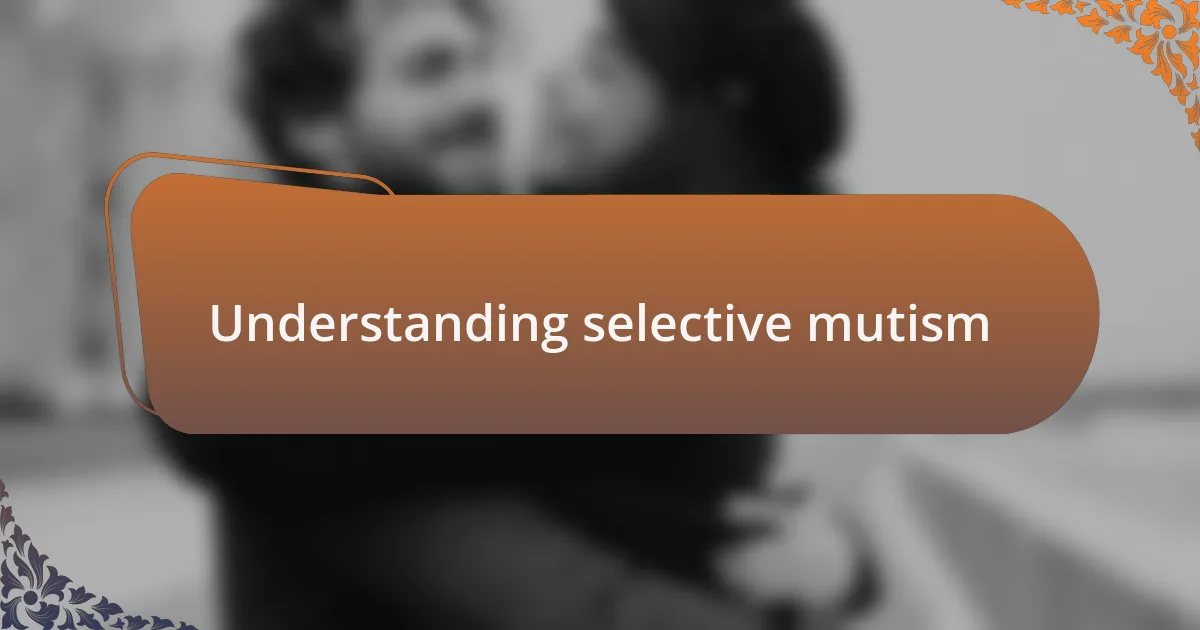
Understanding selective mutism
Selective mutism is a complex anxiety disorder, often seen in children, where an individual struggles to speak in certain social situations despite being able to communicate comfortably in others. I remember the first time I witnessed a child with this condition—it was at a school event. Watching him interact freely with his parents yet completely withdraw from conversation with classmates was a poignant reminder of how isolating this experience can be.
Many people might wonder why someone would seem perfectly fine in one scenario but suddenly become silent in another. This disconnect can stem from overwhelming anxiety, leaving the individual feeling trapped in a web of their own thoughts. I’ve had moments where talking in a small group felt like climbing a mountain, the pressure mounting until all I could do was listen.
Understanding selective mutism requires recognizing that it’s not simply shyness or a refusal to speak; it’s a genuine struggle rooted in fear and stress. Imagine being in a room filled with friendly faces but feeling like every word is a weight on your chest—this insight can help bridge the empathy gap for those who may not have firsthand experience. Reflecting on these emotions and perspectives can foster a deeper connection and understanding for anyone navigating this challenging condition.

Effects of selective mutism
The effects of selective mutism extend beyond just the inability to speak; they can lead to significant emotional distress and social isolation. I remember a time when I saw a child who clung to the edges of a birthday party, visibly anxious as laughter and chatter surrounded them. Watching from afar, I couldn’t help but think about how overwhelming such social situations can be for someone grappling with this condition.
Living with selective mutism often means facing a constant struggle with the expectations of others. People may not understand why a child can respond comfortably at home but suddenly shrinks into silence outside. Have you ever felt the pressure of needing to speak but couldn’t find the words? It’s a tormenting experience that many face daily, leaving them feeling misunderstood and alone.
Over time, the persistent fear associated with speaking situations can take a toll on one’s self-esteem and confidence. I recall meeting someone who had slowly begun to open up in therapy; their journey of progress was marked by small victories, but each step left a lasting impact on their belief in themselves. This illustrates that while selective mutism may create barriers, it can also inspire resilience, showcasing the strength it takes to navigate an often bewildering world.
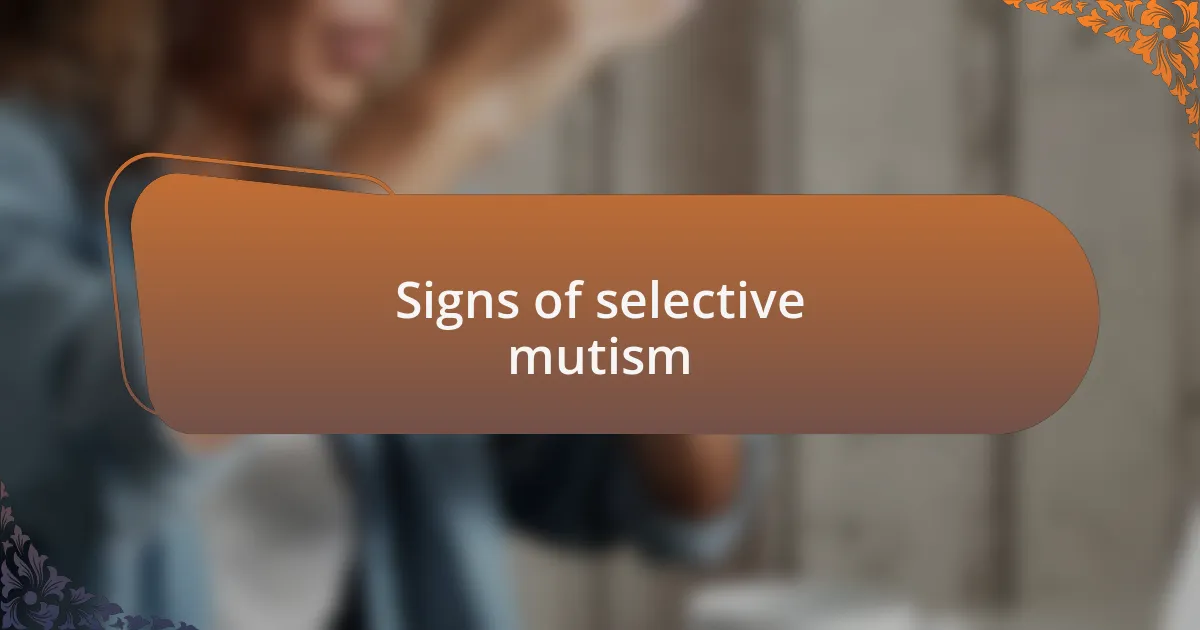
Signs of selective mutism
When it comes to identifying signs of selective mutism, one of the most noticeable behaviors is a child’s reluctance or refusal to speak in specific social settings. I remember observing a little girl in my neighborhood who would only communicate through nods and gestures at school but could sing her favorite songs at home. This stark contrast can often leave parents and teachers puzzled, as they question why a child seems comfortable at home but transforms into a silent observer elsewhere.
Another sign that often goes unnoticed is the intense anxiety that can manifest in various ways. Children might display signs of distress, such as fidgeting or avoiding eye contact, when faced with speaking situations. I once witnessed a young boy clutching a stuffed animal tightly during a classroom activity, a tangible symbol of his need for comfort and security amidst the overwhelming pressure to speak. Has anyone stopped to consider how much courage it takes for a child to even step into a social environment when their world feels like it’s closing in?
Additionally, these children often communicate their feelings through alternative means, like drawing or writing. I’ve seen how art can become an outlet for expression, helping kids convey emotions they cannot articulate verbally. It’s fascinating to think about the depth of thoughts and feelings they hold inside, all while wishing they could share them with friends but feeling stuck in silence. Isn’t it a reminder that communication isn’t solely about words?
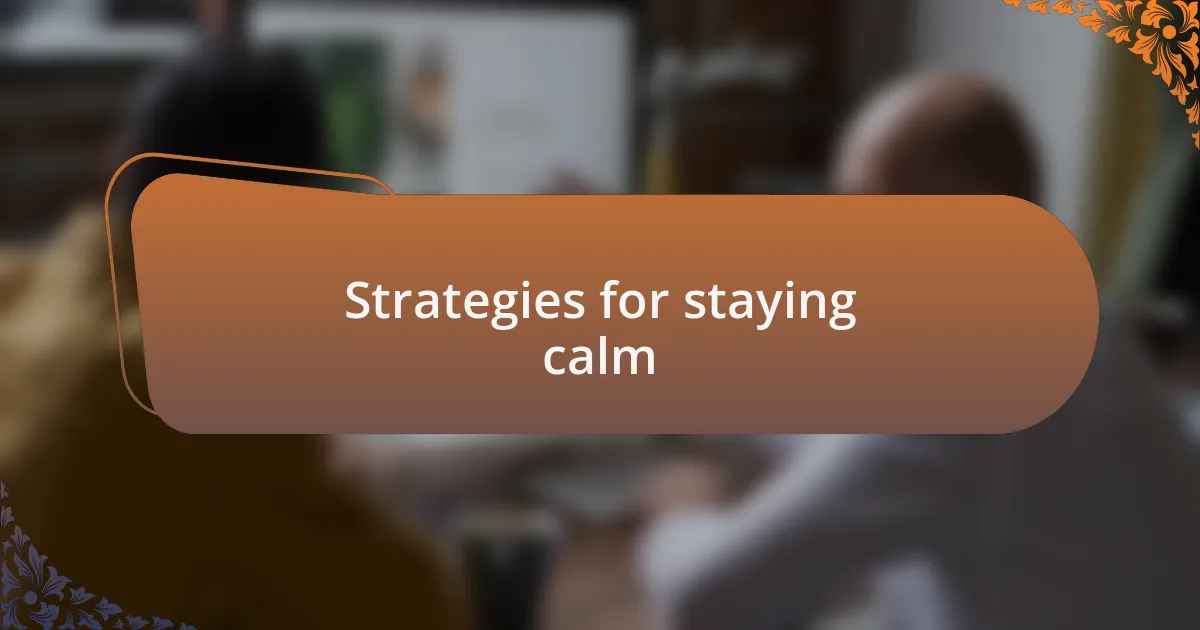
Strategies for staying calm
One effective strategy for staying calm in public is to practice deep breathing exercises. I remember a time when I felt overwhelmed in a crowded place; taking a moment to breathe in deeply and exhale slowly helped me regain my composure. Have you ever tried focusing on your breath during stressful moments? It can truly shift your perspective and ground you.
Creating a small toolkit of comforting items can also be incredibly helpful. I carry a little stress ball in my pocket that I can squeeze discreetly when I start to feel anxious. It’s surprising how such a simple object can remind me that I have control, even in chaotic situations. Isn’t it interesting how tangible objects can evoke a sense of calm and security?
Lastly, visualizing a safe space or a pleasant memory can be a powerful tool. I often close my eyes and imagine my favorite quiet spot in nature, where I feel completely at peace. It transports me away from the noise and tension around me. Have you ever considered how a mental escape could provide the clarity you need during overwhelming moments?
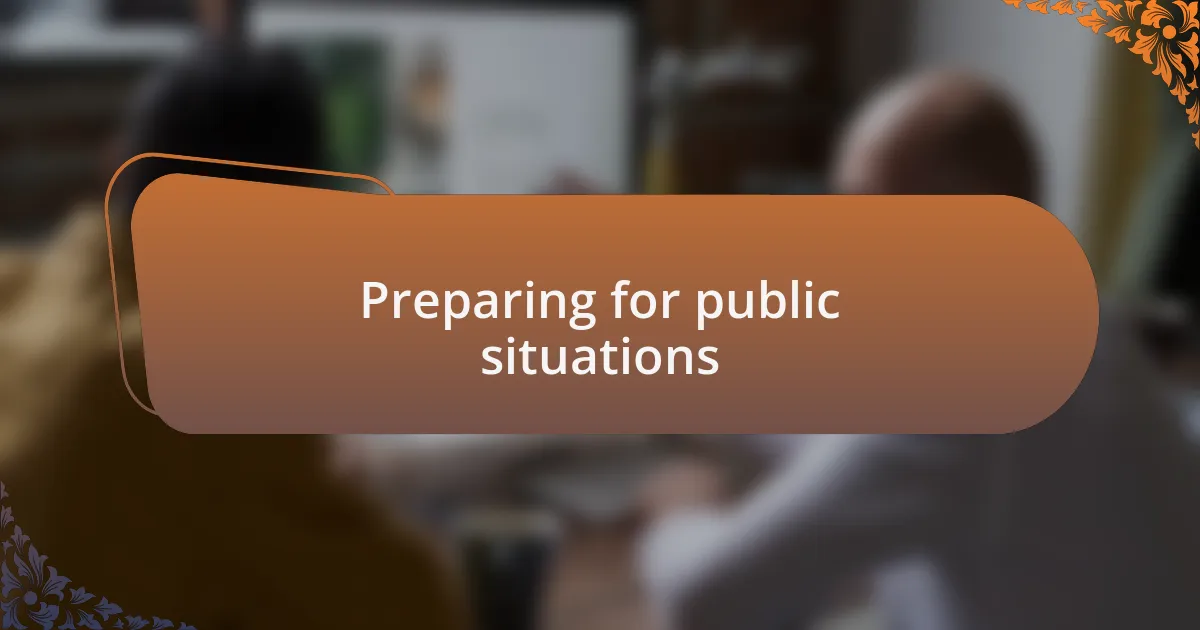
Preparing for public situations
When I prepare for a public situation, I often create a mental outline of the scenario. This includes visualizing who will be there, the environment, and my responses. I remember feeling distinctly less anxious at a family gathering when I practiced this beforehand; by picturing myself engaging calmly, I felt more in control and ready. Have you ever found that a little mental rehearsal can change your entire outlook?
Another technique that works wonders for me is planning my escape routes. Knowing how I’ll exit a situation if it starts to feel overwhelming gives me a sense of security. In one instance, during a crowded event, I identified the nearest exits and felt an unexpected wave of calm wash over me, simply knowing I had options. Isn’t it reassuring to have a plan in place?
I also rely heavily on affirmations before stepping into public spaces. I take a moment to remind myself of my strengths and capabilities. There’s something empowering about telling myself, “I can do this,” before entering a room full of people. Have you ever found that a few positive words can transform your mindset and approach to a situation?
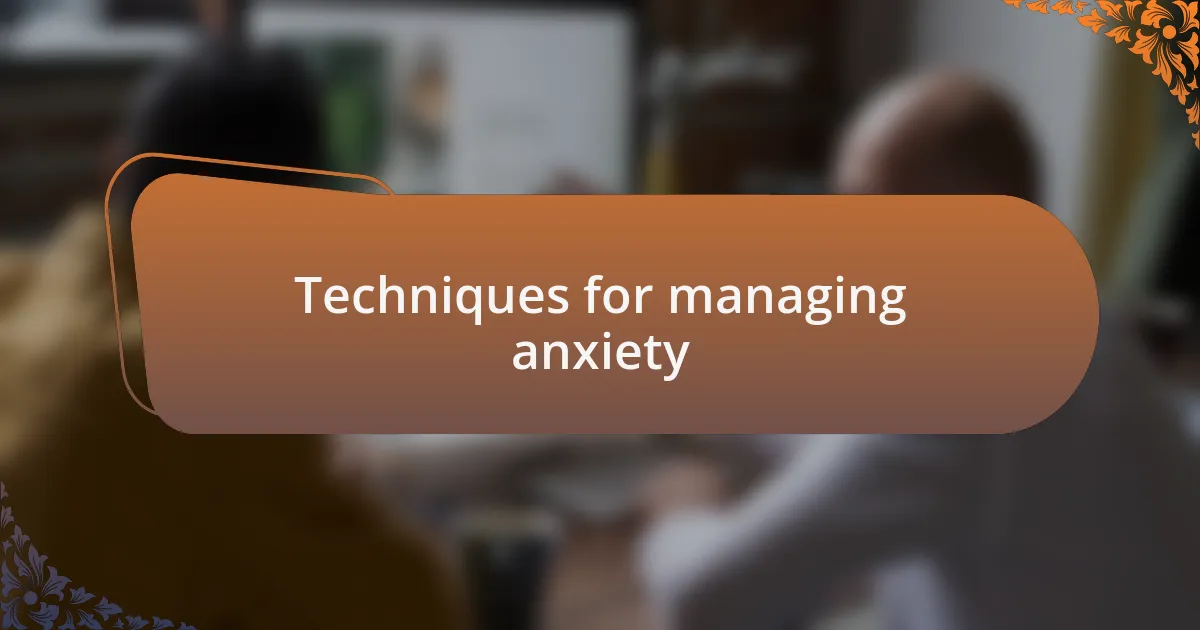
Techniques for managing anxiety
One technique I find helpful for managing anxiety is deep breathing. When I feel that familiar knot in my stomach, I take a moment to focus on my breath. Inhale slowly for four counts, hold for four, and then exhale for six. This simple practice can ground me instantly; during a particularly stressful meeting, I tried this and noticed how quickly my heart rate slowed down. Have you ever realized how a couple of deep breaths can change everything?
Another method I’ve embraced is journaling my thoughts. I often jot down what’s swirling in my mind before facing a social situation. The act of writing it out helps me to understand my feelings better and often leads to surprising clarity. I still remember when I wrote about my anxiety before a gathering, and it ended up revealing that most of my fears were unfounded. Isn’t it powerful how putting pen to paper can shed light on our inner thoughts?
Lastly, I rely on grounding techniques, which might sound simple, but they’re incredibly effective. When I’m standing in a public space, I focus on what I can see, hear, and feel around me. During a recent outing, I felt overwhelmed, so I started naming five things I could see—it instantly pulled me away from spiraling thoughts. Have you ever felt the world around you become more vivid when you consciously engage your senses?
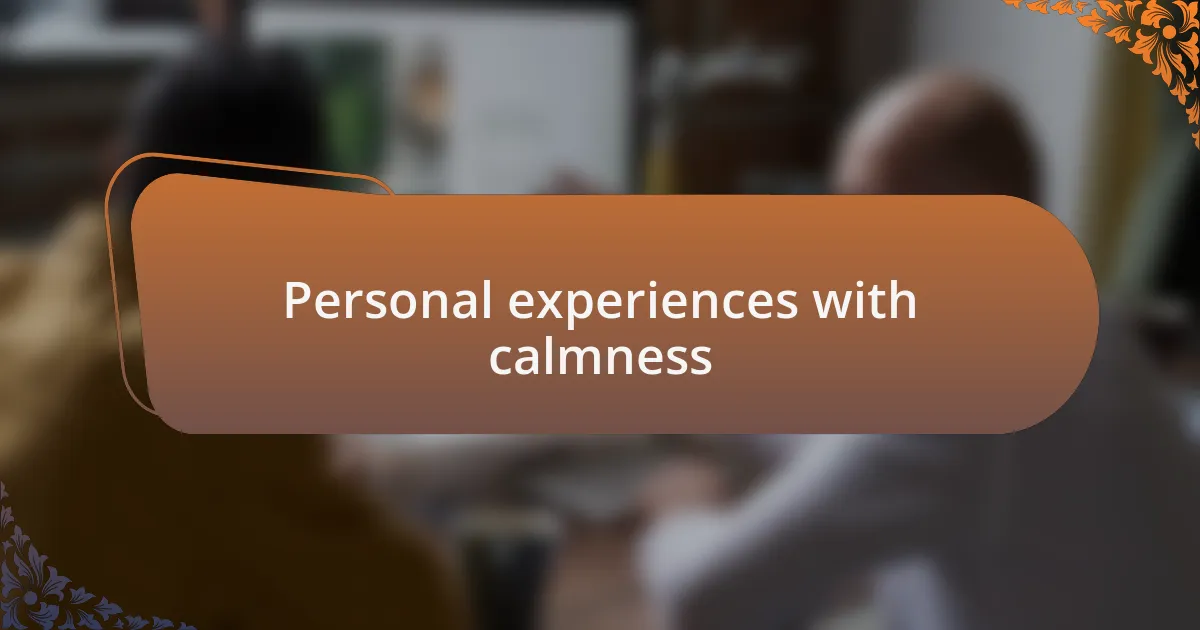
Personal experiences with calmness
There was a moment when I stood in line at a coffee shop, my heart racing as the chatter around me grew louder. I remembered to focus on my senses; the smell of freshly ground coffee and the warmth of the sun streaming through the window brought a wave of calm. In that instant, I thought, isn’t it fascinating how grounding ourselves in the present can ease our worries?
On another occasion, I found a quiet corner at a busy event to collect my thoughts. I closed my eyes briefly and visualized a safe space, a place where I could breathe freely without the pressure of social expectations. It made me realize that even the smallest retreat can provide a profound sense of calm; have you ever taken a moment to just envision your happy place amidst the chaos?
Lastly, I’ve discovered the benefits of a soothing mantra. Whenever I felt the anxiety creeping in during social gatherings, I’d silently repeat, “I am enough,” which became my anchor. This simple phrase served not only as reassurance but also as a gentle reminder that my worth isn’t defined by my ability to speak in public. Doesn’t it strike you how powerful self-affirmation can be in those overwhelming moments?